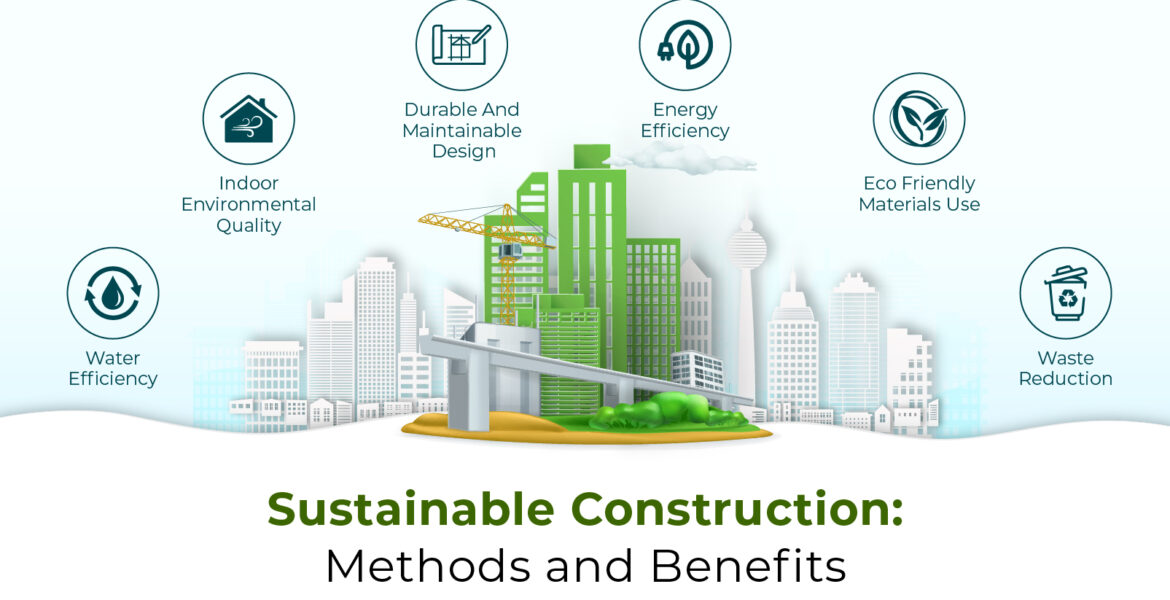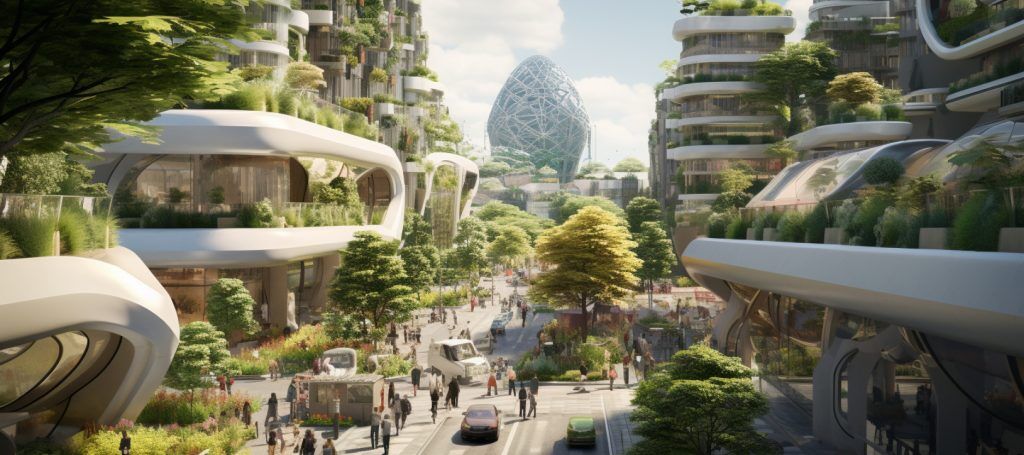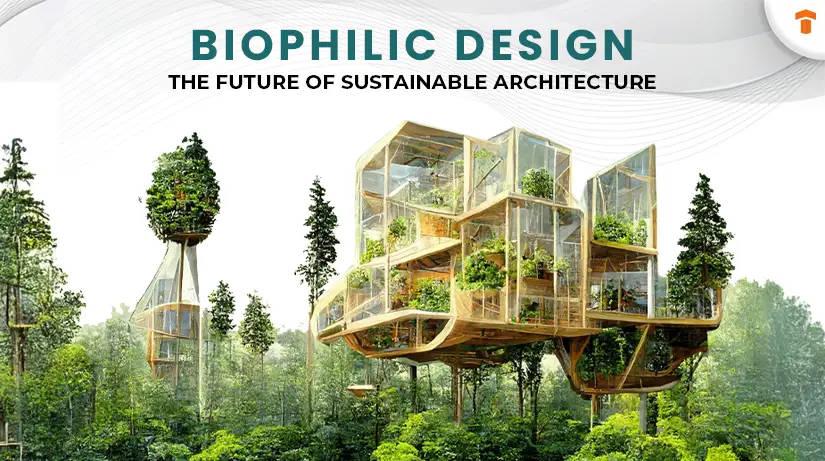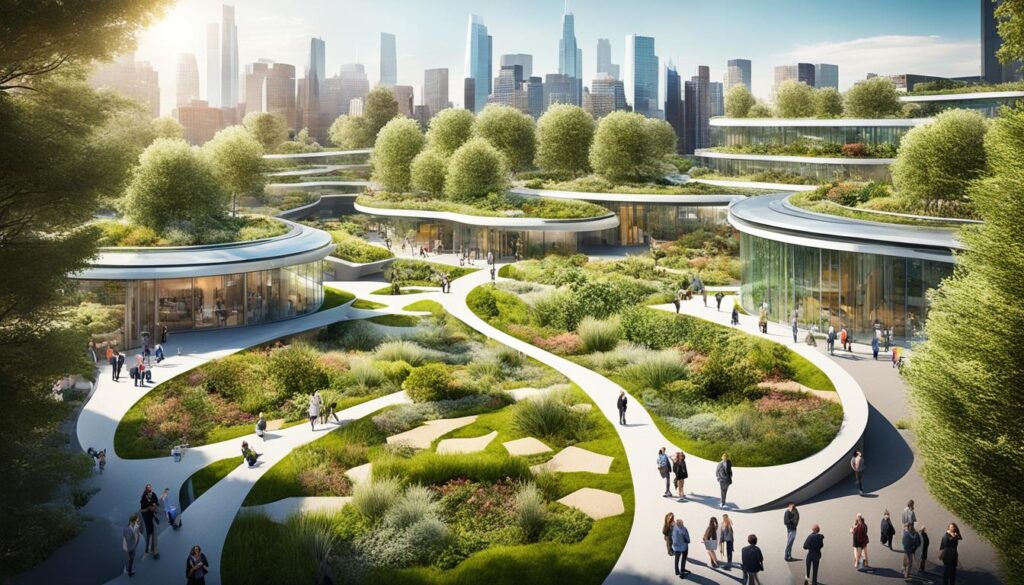Waste Reduction Through Sustainable Building Practices.
Sustainable building represents more than a mere trend; it is a crucial approach to designing structures that align with environmental considerations.
This article examines the concept of sustainable building, outlining its core principles and its importance in contemporary society.
It presents the numerous benefits—ranging from environmental to economic—that arise from the implementation of sustainable practices, as well as the critical elements that contribute to their effectiveness.
Additionally, the article highlights innovative strategies for waste reduction and provides practical examples that demonstrate the potential of sustainable architecture.
It aims to enhance understanding of how these practices are contributing to the creation of a better future for both our planet and our communities.
What Is Sustainable Building?
.jpg_00.jpeg)
Sustainable building, commonly referred to as green architecture, entails the practice of designing and constructing structures that are environmentally responsible and resource-efficient throughout their entire lifecycle. This approach encompasses a range of strategies, including the utilization of eco-friendly materials and eco-conscious construction techniques, implementation of energy-efficient systems, and adoption of waste reduction techniques such as recycling and waste diversion, all aimed at minimizing the environmental impact associated with the building process and fostering healthier living environments for occupants.
Sustainable building principles incorporate the use of renewable resources, effective waste management, and reduction of energy consumption, which are critical in addressing climate change and promoting environmental sustainability. By prioritizing sustainable practices, including life cycle assessment and responsible sourcing, stakeholders contribute to a circular economy that emphasizes resource conservation and minimizes the overall carbon footprint of construction activities.
1. Definition
The definition of sustainable building refers to structures that are designed and constructed in accordance with eco-conscious principles, emphasizing environmental stewardship and resource conservation.
These buildings encompass various dimensions, including the use of eco-friendly materials that are sourced responsibly to mitigate harmful impacts on ecosystems. For example, selecting recycled or rapidly renewable resources contributes to waste minimization and reduces the carbon footprint associated with conventional materials. Incorporating biodegradable materials and local sourcing further enhances the sustainability of these practices.
Sustainable building frequently incorporates innovative designs focused on maximizing energy efficiency, such as integrating natural lighting and ventilation systems. By adopting sustainable sourcing practices and utilizing alternative building materials, builders not only enhance environmental health but also foster a more circular economy, where resources are reused and repurposed instead of discarded.
This approach ultimately leads to a substantial reduction in overall environmental impact and supports habitat restoration and preservation efforts.
2. Principles
The principles of sustainable design emphasize the creation of buildings that enhance energy efficiency, incorporate passive design techniques, and adopt the concepts of a circular economy to minimize waste and conserve resources. These principles are fundamental in promoting industrial ecology and urban ecology in sustainable communities.
These principles are further reflected in the implementation of energy management systems, which facilitate the monitoring and optimization of energy usage, ensuring that buildings operate at peak efficiency.
Natural ventilation is essential for improving indoor air quality while decreasing dependence on mechanical cooling systems.
By designing spaces that promote resilience against the impacts of climate change, architects can create environments that not only endure environmental stressors but also enhance the well-being of occupants.
Moreover, sustainable landscaping practices contribute significantly to environmental sustainability by enhancing biodiversity, managing runoff, and creating inviting outdoor spaces that encourage community interaction.
3. Importance
The significance of sustainable building is evident in its capacity to substantially mitigate environmental impact, promote health and well-being, and encourage community engagement in sustainable practices. By incorporating sustainable technologies and green certifications, these practices enhance the ecological footprint of urban development.
By incorporating eco-friendly materials and energy-efficient technologies, sustainable construction not only reduces energy consumption but also diminishes greenhouse gas emissions, thereby contributing to a lower carbon footprint.
These methodologies create healthier indoor environments, which are crucial for the well-being of occupants, as they ensure enhanced air quality through the use of non-toxic materials and effective ventilation systems.
When communities implement sustainable building strategies, they bolster their resilience to climate change, fostering environments capable of adapting to unpredictable weather patterns and other environmental stresses.
Furthermore, these practices support economic viability by often resulting in reduced operational costs and promoting urban planning initiatives that align with sustainability objectives, thereby benefiting both current residents and future generations.
What Are The Benefits Of Sustainable Building?
Sustainable building provides a comprehensive array of benefits that can be classified into three primary categories: environmental, economic, and social.
Each of these categories plays a significant role in enhancing the overall well-being of both communities and ecosystems.
1. Environmental Benefits
The environmental benefits of sustainable building encompass enhanced environmental sustainability, pollution prevention, and effective resource recovery through waste audits and demolition waste management, all of which collectively contribute to a healthier planet.
These benefits are evident in various practical applications; for example, sustainable building practices often lead to a substantial reduction in construction waste and post-consumer waste, as innovative materials and methods are utilized to minimize excess, supporting zero waste initiatives.
Such structures are typically designed with a focus on energy efficiency, employing improved insulation and renewable energy sources, which results in lower emissions throughout their operational lifespan.
Incorporating biophilic design principles, which emphasize the connection between humans and nature, fosters environments that not only enhance occupant well-being but also support biodiversity and habitat preservation.
Moreover, green infrastructure, including green roofs, rain gardens, and sustainable site management strategies, plays a crucial role in restoring natural habitats, thereby enhancing the overall health of ecosystems while effectively managing stormwater and mitigating urban heat effects.
2. Economic Benefits
The economic benefits associated with sustainable building practices encompass enhanced economic viability, reduced lifecycle costs, and the effective implementation of smart building technologies designed to optimize resource utilization through energy-efficient appliances and green supply chain practices.
These elements collectively contribute to long-term savings, significantly improving energy efficiency and lowering operational costs. Furthermore, incorporating green certifications and eco-labeling not only serves to validate these practices but also enhances property market value by making buildings more appealing to environmentally conscious investors.
Sustainable procurement practices are essential in promoting economic growth, as they encourage a transition toward the use of sustainable materials and services, thereby stimulating local economies.
By adopting these strategies, stakeholders can achieve a favorable impact on both financial performance and environmental health, paving the way for a sustainable future through green finance and sustainable procurement.
3. Social Benefits
.jpg_01.jpeg)
Sustainable building practices confer substantial social benefits, enhancing health and well-being while fostering community resilience and promoting social sustainability. These practices support environmental justice by ensuring equitable access to green spaces and sustainable infrastructure.
These impacts extend beyond mere aesthetics; they cultivate environments that improve air quality, reduce stress levels, and provide essential access to green spaces. By incorporating nature into urban settings through sustainable landscaping and urban development, residents are encouraged to engage in outdoor activities, leading to improved physical and mental health outcomes.
Furthermore, sustainable initiatives often promote stronger social connections through shared public spaces and community events, facilitating interactions that strengthen relationships among residents.
To fully realize these benefits, it is essential for stakeholders to actively engage with the community throughout the planning and implementation phases, fostering a culture of environmental education and social responsibility.
Such engagement ensures that the needs and aspirations of the community are prioritized, resulting in buildings that function not merely as shelters, but as integral components of vibrant, health-focused neighborhoods.
What Are The Key Elements Of Sustainable Building Practices?
The essential components of sustainable building practices encompass energy efficiency, waste reduction, the utilization of sustainable materials, and water conservation. Additionally, sustainable urbanism and climate-responsive design are critical in ensuring the adaptability and resilience of built environments.
Each of these elements plays a crucial role in minimizing environmental impact.
1. Energy Efficiency
Energy efficiency in sustainable building emphasizes the importance of minimizing energy consumption and utilizing renewable resources to reduce the overall carbon footprint of structures, while incorporating energy conservation and emissions reduction strategies.
To achieve this objective, the integration of smart building technologies, such as automated lighting, smart thermostats, and advanced HVAC systems, significantly enhances energy management and building performance. These systems facilitate real-time monitoring and control of energy usage, thereby optimizing performance.
Additionally, employing passive design strategies—such as maximizing natural light and optimizing building orientation—can further diminish reliance on artificial energy sources. The incorporation of renewable energy solutions, including solar panels and wind turbines, can also play a substantial role in reducing energy demands and supporting infrastructure sustainability.
By adopting these methodologies, the pursuit of energy efficiency not only advances sustainable building practices but also contributes to a healthier environment by integrating eco-friendly materials and smart building technologies.
2. Water Conservation
Water conservation within sustainable building practices entails the implementation of strategies such as graywater reuse, rainwater harvesting, and the use of renewable resources to optimize water utilization and minimize waste.
These techniques not only alleviate the pressure on local water resources but also promote a more sustainable environment. By capturing and repurposing water from sinks and showers, individuals can significantly decrease their dependence on freshwater sources.
The incorporation of rainwater harvesting systems encourages the utilization of natural precipitation, fostering ecological awareness. The benefits of these practices extend beyond mere conservation; they play a vital role in sustainable landscaping by ensuring plant health and supporting biodiversity.
Ultimately, the adoption of these water-saving methods contributes to overall ecological health while laying the foundation for future generations to thrive sustainably.
3. Waste Reduction
Waste reduction is an essential aspect of sustainable building, emphasizing the importance of recycling, composting, and effective waste management strategies to minimize environmental impact.
This process entails conducting targeted waste audits to identify the types and quantities of waste generated on-site, which provides valuable insights that inform improved recycling and composting practices.
The use of mobile recycling units can facilitate the sorting and repurposing of materials directly at construction sites, thereby enhancing the efficiency of waste diversion efforts.
Furthermore, designing for disassembly ensures that structures can be easily dismantled, allowing for the reuse of components and preventing valuable materials from being discarded in landfills. Collectively, these techniques reinforce the commitment to achieving zero waste goals while promoting a culture of sustainability within construction practices.
4. Use of Sustainable Materials
The utilization of sustainable materials, including eco-friendly and reclaimed options, is fundamental in sustainable building practices. This approach promotes resource efficiency, supports sustainable construction, and mitigates environmental impact while adhering to green building standards.
Such practices not only conserve natural resources but also support ethical sourcing by prioritizing materials that are harvested responsibly, thereby minimizing harm to ecosystems. As awareness of sustainability issues increases, builders and designers are increasingly relying on eco-labeling to identify products that comply with stringent environmental criteria, ensuring transparency in their sourcing methods.
The incorporation of post-consumer waste into construction exemplifies innovative solutions, as upcycling transforms discarded materials into valuable resources. This practice not only diverts waste from landfills but also fosters a circular economy, in which materials are continuously reused, reducing the demand for virgin resources and decreasing the overall carbon footprint.
How Can Sustainable Building Practices Reduce Waste?
Sustainable building practices can substantially minimize waste by implementing innovative approaches, including design for deconstruction and efficient waste management strategies that prioritize recycling, resource recovery, and waste minimization practices.
1. Design for Deconstruction
.jpg_10.jpeg)
Design for deconstruction represents a sustainable approach that facilitates the future dismantling of buildings, prioritizing resource recovery, material reuse, and adhering to the waste hierarchy while promoting sustainable design principles.
This methodology encourages architects and builders to deliberately select materials and construction techniques that not only simplify future disassembly but also maximize the potential for reusing or recycling components. By emphasizing the ease of deconstruction, this approach minimizes waste and reduces the carbon footprint associated with demolition.
An exemplary case is the Bullitt Center in Seattle, which embodies this principle through modular design, enabling specific parts of the structure to be reclaimed and reused without compromising the overall integrity.
Similarly, the renovation of the old Zollverein Coal Mine industrial complex illustrates how design for deconstruction can revitalize obsolete structures, demonstrating significant resource efficiency while promoting sustainable development.
2. Use of Recycled Materials
The incorporation of recycled materials in construction not only fosters eco-friendly building practices but also enhances resource recovery, supports circular economy principles, and decreases the reliance on virgin materials.
This practice encompasses a range of materials, including reclaimed wood, recycled metals, and repurposed concrete, each presenting distinct advantages.
- For example, reclaimed wood offers both aesthetic appeal and durability,
- whereas recycled metals contribute to structural strength and resilience, significantly reducing the need for resource extraction.
Innovative projects worldwide illustrate the creative application of these materials; for instance, some architects are now utilizing crushed concrete as a sustainable alternative to traditional aggregate in new constructions.
Such initiatives not only mitigate waste but also support the establishment of a more sustainable supply chain, ultimately resulting in reduced carbon footprints and a more responsible approach to construction.
3. Waste Management Strategies
Effective waste management strategies, including waste audits, source separation, and waste diversion techniques, are essential for minimizing construction waste and promoting sustainability in building practices through the lens of sustainable procurement and construction best practices.
The incorporation of innovative methods, such as on-site separation of materials and the use of mobile recycling units, can significantly enhance these efforts. Mobile units have the capability to process and recycle materials directly at construction sites, thereby reducing the carbon footprint associated with waste transportation.
Engaging the local community in these practices cultivates a sense of responsibility and encourages collaborative solutions for waste reduction. Conducting workshops and informational sessions can enable residents to actively participate in recycling initiatives, highlighting the collective benefits of sustainable practices within the building industry.
What Are Some Examples Of Sustainable Building Practices?
Sustainable building practices encompass a diverse array of strategies, including green roofs, solar panels, and passive solar design, all of which are intended to improve environmental performance and enhance resource efficiency.
1. Green Roofs
Green roofs represent an innovative and sustainable building practice that significantly enhances environmental sustainability. They provide insulation, reduce heat, promote biodiversity within urban areas, and align with green architecture and low-impact development principles.
These systems play a critical role in stormwater management by absorbing rainwater, thereby mitigating flooding and alleviating the burden on municipal drainage systems. By improving energy efficiency, green roofs can lead to reduced heating and cooling costs for buildings, contributing to an overall decrease in energy consumption.
Cities such as Toronto and Chicago have recognized the value of green roofs, incorporating them into their urban planning strategies to combat the urban heat island effect and enhance air quality. Such initiatives not only yield environmental benefits but also improve the aesthetic appeal of urban landscapes.
2. Solar Panels
Solar panels represent a fundamental element of sustainable building practices, as they harness renewable energy to minimize energy consumption, reduce utility costs for both homeowners and businesses, and contribute to emissions reduction and improved building performance.
By integrating various types of solar panels, including photovoltaic (PV) and solar thermal systems, residential and commercial buildings can significantly enhance their energy efficiency. PV panels convert sunlight directly into electricity, making them particularly suitable for powering appliances and lighting. In contrast, solar thermal systems are designed for heating water, thereby supporting a range of building functions.
The financial advantages associated with these implementations are noteworthy; they can lead to substantial reductions in monthly energy expenses and may also qualify individuals and businesses for tax incentives and rebates. From an environmental perspective, the adoption of solar energy contributes to a reduction in greenhouse gas emissions, fostering a cleaner and more sustainable future.
3. Rainwater Harvesting
Rainwater harvesting is a sustainable building practice that captures and utilizes rainwater for irrigation and other non-potable applications, thereby contributing to water conservation, resource recovery, and supporting sustainable urbanism initiatives.
This practice assists in managing stormwater runoff while simultaneously reducing the demand on municipal water supplies, which makes it an essential component of environmentally friendly urban planning.
Various systems have been developed, ranging from simple rain barrels to advanced underground cisterns equipped with filtration and pumping technologies.
Cities such as San Francisco have successfully implemented rainwater harvesting on a larger scale, enabling the use of collected rainwater for green spaces and public parks.
These initiatives not only enhance the resilience of urban landscapes against climate change but also promote biodiversity by sustaining vibrant environments.
Such implementations underscore the vital role that rainwater harvesting plays in facilitating sustainable landscaping practices, sustainable urbanism, and improving overall urban sustainability through effective stormwater management and water conservation.
4. Passive Solar Design
.jpg_11.jpeg)
Passive solar design represents a sustainable architectural approach that optimizes the utilization of natural light and heat, thereby enhancing energy efficiency, promoting sustainable design, and reducing dependence on mechanical heating and cooling systems.
This innovative methodology underscores the importance of strategically orienting the building to effectively capture sunlight during the winter months while minimizing exposure during the warmer seasons. By incorporating thermal mass materials such as concrete or stone, structures can proficiently store and release heat, ensuring a comfortable indoor environment throughout the year.
Moreover, the implementation of appropriate shading techniques—ranging from overhangs to adjustable awnings—can mitigate excessive solar gain during peak hours, further optimizing energy consumption and enhancing building performance through passive design.
These principles not only enhance the performance of the building but also contribute significantly to long-term environmental sustainability by reducing carbon footprints, facilitating recycling and waste diversion, and promoting a more eco-friendly lifestyle.
5. Use of Sustainable Materials
The utilization of sustainable materials in construction is essential for minimizing construction waste, ensuring responsible sourcing, and promoting environmentally responsible building practices.
Considering the increasing focus on environmental stewardship and eco-conscious design, builders are progressively adopting materials such as bamboo, reclaimed wood, and recycled metal, each of which presents distinct advantages.
Bamboo, for example, is not only a renewable resource but also exceptionally strong, rendering it an attractive option for structural components in green architecture and sustainable construction. Reclaimed wood adds character to projects while simultaneously reducing the demand for new timber, thereby contributing to the preservation of forests. Furthermore, the use of recycled metal decreases the carbon footprint associated with the extraction and processing of virgin materials, contributing to emissions reduction and resource efficiency.
Prominent projects, such as the Bullitt Center in Seattle, exemplify how the integration of these materials not only enhances durability but also promotes resilience against climate change, ultimately resulting in buildings that are both environmentally sustainable, eco-friendly, and enduring.
Frequently Asked Questions
What does waste reduction through sustainable building practices mean?
Waste reduction through sustainable building practices refers to the use of environmentally-friendly techniques and materials in the construction, operation, and maintenance of buildings in order to minimize the amount of waste produced and disposed of during the building’s lifecycle, aligning with principles of the circular economy and life cycle assessment.
Why is waste reduction through sustainable building practices important?
Waste reduction through sustainable building practices is important because it helps to protect the environment, conserve natural resources, and reduce the negative impact of construction on local ecosystems. It also helps to lower operating costs for building owners and occupants.
What are some examples of waste reduction through sustainable building practices?
Examples of waste reduction through sustainable building practices include using recycled or renewable materials, such as biodegradable materials and alternative building materials, implementing efficient waste management systems like source separation and waste audits, and incorporating energy and water-saving features into building design.
Who is responsible for implementing waste reduction through sustainable building practices?
The responsibility for implementing waste reduction through sustainable building practices falls on a variety of stakeholders, including architects, contractors, building owners, and occupants, all of whom must engage in community engagement and ecological design. It requires collaboration and commitment from all parties involved in the building’s design, sustainable manufacturing, construction, and use.
What are the benefits of waste reduction through sustainable building practices for building owners?
For building owners, waste reduction through sustainable building practices can result in cost savings through reduced waste disposal fees and lower operating costs, as well as increased property value, improved reputation, and alignment with green building standards and green certifications. It can also help to attract and retain environmentally-conscious tenants.
Are there any regulations or guidelines for waste reduction through sustainable building practices?
Yes, there are various regulations and guidelines at the local, state, and national levels that promote waste reduction through sustainable building practices, including LEED certification, building codes, and environmental regulations. These include building codes, green building certifications, waste management regulations, and guidelines on sustainable procurement and environmental assessments. It is important to consult with these guidelines when planning and implementing sustainable building practices.

I’m Bruno, an architect with a deep passion for Biophilic Design in Urban Architecture. Throughout my career, I’ve focused on integrating natural elements into urban planning, and I created this site to share my insights and foster a deeper understanding of how biophilic principles can significantly enhance urban living. Dedicated to sustainable development, I continually explore innovative design solutions that promote both environmental and human well-being in city landscapes.














Publicar comentário